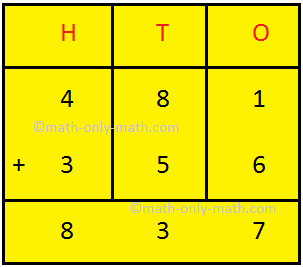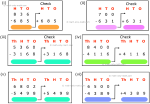Multiplicand and Multiplier
We will learn about the multiplicand and multiplier. The number to be multiplied is called the multiplicand. The number with which we multiply is called the multiplier.
1. Multiply 789 by 8
789 → Multiplicand
× 8 → Multiplier
6312 → Product
2. Multiply 931 by 7
931 → Multiplicand
× 7 → Multiplier
6517 → Product
The result obtained is called the product.
Multiplication by three-digit numbers:
We know how to multiply the numbers by one and two-digit numbers. Now we will learn to multiply the numbers by three-digit numbers.
Multiplication by a three-digit number is done exactly in the same way as we do by two-digit numbers.
Let us consider some
examples:
1. Multiply 546 by 748
546
× 748
4368 → (546 × 8)
21840 → (546 × 40)
382200 → (546 × 700)
408408
So, the product is 408408
2. Multiply 412 by 205
412
× 205
2060 → (412 × 5)
0000 → (412 × 0)
82400 → (412 × 200)
84460
So, the product is 84460
3. Multiply 4392 by 213
4392
× 213
13176 → (4392 × 3)
43920 → (4392 × 10)
878400 → (4392 × 200)
935496
So, the product is 935496.
4. Multiply 3729 by 318
3729
× 318
29832 → (3729 × 8)
37290 → (3729 × 10)
1118700 → (3729 × 300)
1185822
So, the product is 1185822
Properties of multiplication:
We are familiar with the properties of multiplication. Let us recall the properties.
Commutative property of multiplication
If we change the order of the numbers, the product does not change.
For example:
7 × 8 = 56 or 8 × 7 = 56
Therefore, 7 × 8 = 8 × 7
Associative property of multiplication
The product of three or more numbers does not change if we change the grouping of the numbers.
For example:
(6 × 7) × 5 = 42 × 5 = 210
or, (7 × 5) × 6 = 35 × 6 = 210
or, (6 × 5) × 7 = 30 × 7 = 210
One property of multiplication
The product of a number and 1 is the number itself.
For example:
15 × 1 = 15,
25 × 1 = 25,
98 × 1 = 98,
321 × 1 = 321
Zero property of multiplication
The product of any number and zero is zero.
For example:
35 × 0 = 0,
0 × 215 = 0,
240 × 0 = 0,
960 × 0 = 960
Distributive property of multiplication
The product of a number and the sum of two numbers is always the same as the sum of the product of the numbers.
For example:
6 × (7 + 5) = 6 × 12 = 72
6 × 7 + 6 × 5 = 42 + 30 = 72
So, 6 × (7 + 5) = 6 × 7 + 6 × 5 = 72
Similarly, the product of a number and the difference of two numbers is always the same as the difference of the product of the numbers.
For example:
6 × (7 - 5) = 6 × 2 = 12
6 × 7 - 6 × 5 = 42 - 30 = 12
To multiply a number
|
By 10, 20, 30, 40, |
......... → |
multiply the number by 1, 2, 3, 4, ......... and insert one zero on the right of the product. |
|
By 100, 200, 300, 400, |
......... → |
multiply the number by 1, 2, 3, 4,........and insert two zeroes on the right of the product. |
|
By 1000, 2000, 3000, 4000, |
......... → |
multiply the number by 1, 2, 3, 4, ......... and insert three zeroes on the right of the product. |
From Multiplicand and Multiplier to HOME PAGE
Didn't find what you were looking for? Or want to know more information about Math Only Math. Use this Google Search to find what you need.
Recent Articles
-
Worksheet on Mixed Addition and Subtraction | Questions on Addition
Jan 12, 25 02:14 PM
In worksheet on mixed addition and subtraction the questions involve both addition and subtraction together; all grade students can practice the questions on addition and subtraction together. -
Estimating Sums and Differences | Estimations | Practical Calculations
Jan 12, 25 02:02 PM
For estimating sums and differences in the number we use the rounded numbers for estimations to its nearest tens, hundred, and thousand. In many practical calculations, only an approximation is requir… -
Combination of Addition and Subtraction | Mixed Addition & Subtraction
Jan 12, 25 01:36 PM
We will discuss here about the combination of addition and subtraction. The rules which can be used to solve the sums involving addition (+) and subtraction (-) together are: I: First add -
Checking Subtraction using Addition |Use Addition to Check Subtraction
Jan 12, 25 01:13 PM
We can check subtraction by adding the difference to the smaller number. Since the sum of difference and smaller number is equal to the larger number, subtraction is correct. -
Worksheet on Subtraction of 4-Digit Numbers|Subtracting 4-Digit Number
Jan 12, 25 09:04 AM
Practice the questions given in the worksheet on subtraction of 4-digit numbers. Here we will subtract two 4-digit numbers (without borrowing and with borrowing) to find the difference between them.





New! Comments
Have your say about what you just read! Leave me a comment in the box below. Ask a Question or Answer a Question.